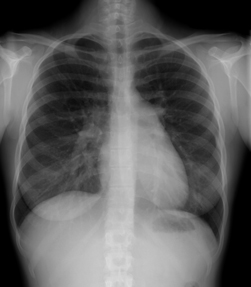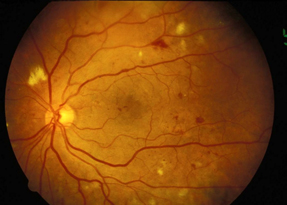Learn to see signs of an often fatal disease
Pulmonary arterial hypertension can be recognized and treated. But it remains a diagnosis that is often missed, and the delay can lead to a rapidly progressing and fatal outcome. Learn the signs beyond a patient who reports “being out of breath.”.
Pulmonary arterial hypertension (PAH), a rapidly progressive and fatal disease if left untreated, is often overlooked as a possible diagnosis in the primary care setting. It mimics other diseases and continues to be missed by physicians who have not placed it farther up their list of possible diagnoses.
Twenty years ago, there were no treatments available. Today, nine FDA-approved treatments, if prescribed early enough in the disease process, may mean a longer life and better quality of life. But even with the remarkable growth in effective treatments, the track record for diagnosis has not changed in 20 years.

“The delay from the time of onset of symptoms to the diagnosis is still about two years in current registries, which is not any different than it was in the [National Institutes of Health] registry conducted in the 1980s,” said Vallerie McLaughlin, MD, director of the pulmonary hypertension program at the University of Michigan in Ann Arbor. “Despite all this education that we are doing and despite all these new treatments, it doesn't seem that doctors are looking for it and diagnosing it any earlier than they were back in the 1980s when we really had no approved therapies at all.”
According to Erika Berman Rosenzweig, MD, medical director of the Pulmonary Hypertension Comprehensive Care Center at Columbia University Medical Center-NewYork Presbyterian in New York City, PAH mimics much more common diseases, such as asthma, and other respiratory diseases, such as chronic obstructive pulmonary disease (COPD). Patients often think they are simply out of shape and don't seek medical attention until the disease has progressed, she said.
The symptoms of PAH are common but nonspecific and include breathlessness on exertion or fatigue during routine activity. Breathlessness on exertion occurs as the first symptom in about 60% of PAH patients; fatigue is the first symptom in about 20% of PAH patients.
Several types of pulmonary hypertension are associated with left heart disease, lung diseases, chronic thromboemboli, or other conditions. Each may cause right heart impairment. PAH is a more rare type of pulmonary hypertension caused by alterations of the pulmonary vasculature directly. It is often misdiagnosed.
If suspicion of PAH is not on the differential list, delayed diagnosis is quite possible, according to C. Gregory Elliott, MD, MACP, medical director of the Pulmonary Hypertension Center at Intermountain Medical Center in Murray, Utah.
“The patients often look well, and there are alternative possible diagnoses that don't require as much testing and can confound the correct diagnosis,” Dr. Elliott said. For example, it is not uncommon for patients to be told that they have asthma, then wonder why they remain so breathless when the asthma is treated.
Patients with idiopathic PAH may not have a lot of other comorbidities, although 10% to 20% of patients may have systemic hypertension, Dr. McLaughlin said. Patients may have lung disease, asthma, or COPD, “but we really don't know if those are comorbid illnesses or if they just get labeled. For example, an otherwise healthy person may complain of shortness of breath and is told she has asthma. Many patients diagnosed with PAH have something like that in their charts, but we don't always know if that was an accurate diagnosis.”
Patients have reported years of frustration as they visit one doctor after another, seeking an explanation for their continuing and worsening fatigue and breathlessness, Dr. Elliott said. Young women are sometimes told they are depressed or out of shape and are not evaluated further. Other patients are prescribed inhalers, exercise and diet changes to cope with their symptoms, but none of those are effective. Other patients may be obese, and their fatigue is assumed to be associated with body weight, sleep-disordered breathing or sleep apnea.
“If the patient has reached a point where they are having a difficult time doing their everyday activities, such as giving up climbing the stairs at work or parking their car closer to the grocery store, that should be a strong signal that there could be a serious problem,” Dr. Elliott said.
Harold Palevsky, MD, FACP, chief of pulmonary medicine and director of the pulmonary vascular disease program at the Penn-Presbyterian Medical Center of the University of Pennsylvania Health System in Philadelphia, agreed. “It is important to evaluate patients with exertional symptoms with a thorough examination, including evaluating them during exertion. None of the symptoms of pulmonary hypertension are specific until somebody has right heart failure, and that's way down the road. We want to make the diagnosis before that point.”
First suspect, then confirm
Diagnosis of PAH begins with the suspicion that breathlessness and fatigue are not related to asthma, sleep apnea or other conditions, and a recognition that the symptoms are progressive and are not responding to treatment for other conditions.
The next step is ordering a transthoracic echocardiogram, one that specifically looks at the right side of the heart and estimates pulmonary artery pressure.
“It is particularly important to let the echocardiographer know that you are specifically interested in the right side of the heart and pulmonary artery pressure,” said Dr. McLaughlin, chair of the American College of Cardiology Task Force on Expert Consensus Documents. If the pulmonary pressures are elevated or if the right side of the heart is enlarged, a suspicion of PAH should move up higher on the differential and the patient should be referred to a specialist for further consideration of the diagnosis, she added.
While the echocardiogram is an essential test in the evaluation of possible PAH, it alone cannot confirm a diagnosis. That requires cardiac catheterization.
“Specialists have a very good sense of the challenges that go into the diagnosis,” Dr. Elliott added. “They have the training, experience and expertise to further the evaluation at that point.” The specialist will confirm the diagnosis with a pulmonary artery catheterization. The catheterization will assess the severity of the condition, help determine the appropriate treatment, and exclude the other types of pulmonary hypertension that are not considered PAH.
Patients with PAH will have elevation of mean pulmonary arterial pressure greater than 25 mm Hg; a pulmonary artery wedge pressure, left atrial pressure, or left ventricular end-diastolic pressure less than or equal to 15 mm Hg; and a pulmonary vascular resistance greater than 3 Wood units, according to the American College of Cardiology Foundation/American Heart Association (ACCF/AHA) 2009 Expert Consensus Document on Pulmonary Hypertension.
Treatment is complex
Treatment is best managed by a specialist, usually a cardiologist or pulmonologist who is familiar with caring for patients with pulmonary hypertension, according to several experts who point to the complexity of the treatments and the need for frequent monitoring of patients. As PAH is seen in association with connective tissue diseases, particularly scleroderma, a growing number of rheumatologists are providing specialized care to patients with PAH as well.
According to Rino Aldrighetti, president and CEO of the Pulmonary Hypertension Association, the number of physicians who treat PAH has grown in 20 years, although many of those treat only a handful of patients with the disease.
“It's a rapidly moving field in terms of research, so it is very important to get patients to expert centers,” he said.
The ACCF/AHA consensus document concurs. Because PAH is a rare and complex disease with high mortality, “most patients should be managed at or in conjunction with a PAH Center of Excellence,” it states. Those centers should specialize in PAH, with physicians who have expertise with the disease and nursing staff specially trained to help manage the patients and therapies.
The available oral PAH-specific treatments include PDE5 inhibitors (sildenafil or tadalalfil); and endothelin receptor antagonists (bosentan or ambrisentan). Other therapies include prostanoids (epoprostenol, treprostinil and iloprost), which are not orally available. Epoprostenol is delivered through continuous IV or subcutaneous infusions. Treprostinil can be delivered through IV infusion, via an intermittent inhaled basis, or on a continuous subcutaneous basis. Iloprost is delivered through an aerosol device.
Determination of the appropriate therapy depends on how far the disease has progressed and the patient's functional class, Dr. McLaughlin advised. A patient whose disease is advanced may be best treated with one of the intravenous or subcutaneous prostacyclines. A patient in functional class II or III whose right ventricle is not more than mildly dysfunctional could be initially treated with one of the oral medications (see chart, “WHO classification of pulmonary hypertension in adults”).
According to Dr. Berman Rosenzweig, there is no “gold standard” of treatment for PAH. “The gold standard was continuous IV prostanoid, but now with oral drugs and some inhaled drugs, using them alone or in combination, it really does depend on the patient and how limited they are as to which combination or medication is needed,” she said.
Comanagement is essential
Even though the patient's PAH should be managed by a specialist, experts agree that the internist is vital to patient care.
“In my practice, the internist remains a very important partner in the care of the patient,” Dr. Elliott said. “We really must comanage the patient. As a specialist, we accept the responsibility for expertise and care of the pulmonary hypertension, but we look to our internist colleagues to assure that our patients are receiving their health maintenance.”
Dr. McLaughlin said it is critically important that patients with PAH also continue to see their primary care physician. Patients who develop heart failure need their local doctor to manage fluids and assess diuretics and electrolytes. The internist can also monitor intravenous line infections.
Patients with PAH should also be counseled about necessary adjustments in lifestyle, depending on disease severity. Most important, women with PAH should not get pregnant, given the 30% to 50% maternal mortality rate, according to the ACCF/AHA consensus document. Some patients can hold full-time jobs but need to have certain limits at work; others are more closely tied to home and must use a wheelchair.
“Depending on the type and severity of the disease, many patients with treatment can go back to doing some of their regular activities but need to be alert to things like extreme hot- and cold-weather conditions and to overexertion that can lead to worsening symptoms,” Dr. Berman Rosenzweig said.
Patients should be given an exercise test before engaging in rigorous exercise. Patients in a lower functional class may need management of potential heart failure symptoms, including restricting sodium to less than 2,400 mg/d, taking diuretics for weight gain, and doing no heavy lifting to prevent an increase in intrathoracic pressure and fainting. “We encourage graded aerobic exercise, but not heavy lifting,” Dr. McLaughlin said.
Prognosis varies, with about 10% to 15% of treated patients dying each year, even with advanced therapies, according to Dr. McLaughlin. “However, even a very ill patient may do well if they have a very good response to therapy. If they respond well in six months to a year, then it's likely that that patient is going to do well and is one of the reasons why it is important to keep the specialist involved in following the patient,” she said.
Patients with more advanced disease, such as those who remain in functional class III or IV and do not respond to the most aggressive therapies, have poor outcomes and may eventually need evaluation for lung transplantation, she said.
In general, experts said, early diagnosis and treatment are key to a patient's quality of life and survival. “While PAH is progressive and potentially fatal if untreated, if it is recognized early and treatment is instituted early, we know the outcomes are better,” Dr. Berman Rosenzweig said. “Internists should not forget about this disease state.”





